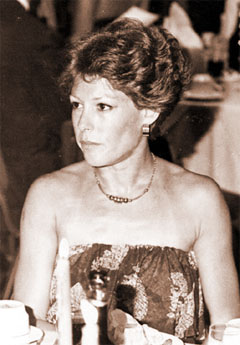|
| Magriel's NYT Columns |


Tobias Stone and Lyn Goldsmith The Empire State Backgammon championship Tournament, sponsored by the World Backgammon Club, was held a week ago at the Manhattan Bridge Club in New York. In order to limit the event to one evening, all matches had to be restricted to 9 points. The winner was Mike Singer, who beat Tobias Stone in the finals. Douglas Huch triumphed over A. Alkceder to win the consolation flight.
The hardest-fought match was the semifinals between two world-class players, Tobias Stone and Lyn Goldsmith. Miss Goldsmith is widely considered the world’s best woman player. Stone, noted for his backgammon expertise, is even better known for his bridge accomplishments. Along with Alvin Roth, he created the Roth-Stone system, with which they revolutionized bidding strategy and took many national titles.
The diagrammed position, taken from the Stone-Goldsmith match, illustrates the tactics of aggressive modern opening strategy in backgammon. Just before this position was reached, Goldsmith (White) began the game with a roll of 4-3. She played 1/5, 12/15, making an early bid to seize the 5-point by splitting her back runners. (Expert players consider the 5-points on both sides of the board the critical points to control early in the game. For this reason, many games between them begin with violent fighting for these points.)
|
| Black to play 5-3. |
The correct play is 8/5*, 6/1*, hitting both of White’s back men. However, this move leaves two blots (on the 1- and 5-points) exposed to attack by White’s men reentering from the bar, and may thus appear unnecessarily risky. Compare the correct play and the alternative play, 13/5*, hitting and leaving only one man exposed.
|
|
|
Stone eventually won his semifinals match, 9–8, but (as often seems the case when one match is particularly hard-fought) he succumbed next round to Singer.
Rollout
 Tom Keith 2013 |
|
Money play Centered cube Black rolls 5-3 1296 games with VR Checker play: 2-ply Cube play: 3-ply Red |
| 5-3: | Game | G | BG | Equity | ||||
| 1 | 13/5* |
W L |
.4780 .5220 |
.1385 .1529 |
.0066 .0097 | −0.1002 |

| (b) |
| 2 | 8/3, 6/3 |
W L |
.4586 .5414 |
.1257 .1495 |
.0052 .0076 | −0.1607 | (0.0605) | |
| 3 | 8/5*, 6/1* |
W L |
.4570 .5430 |
.1310 .1687 |
.0052 .0108 | −0.1985 | (0.0983) | (a) |

|
|

